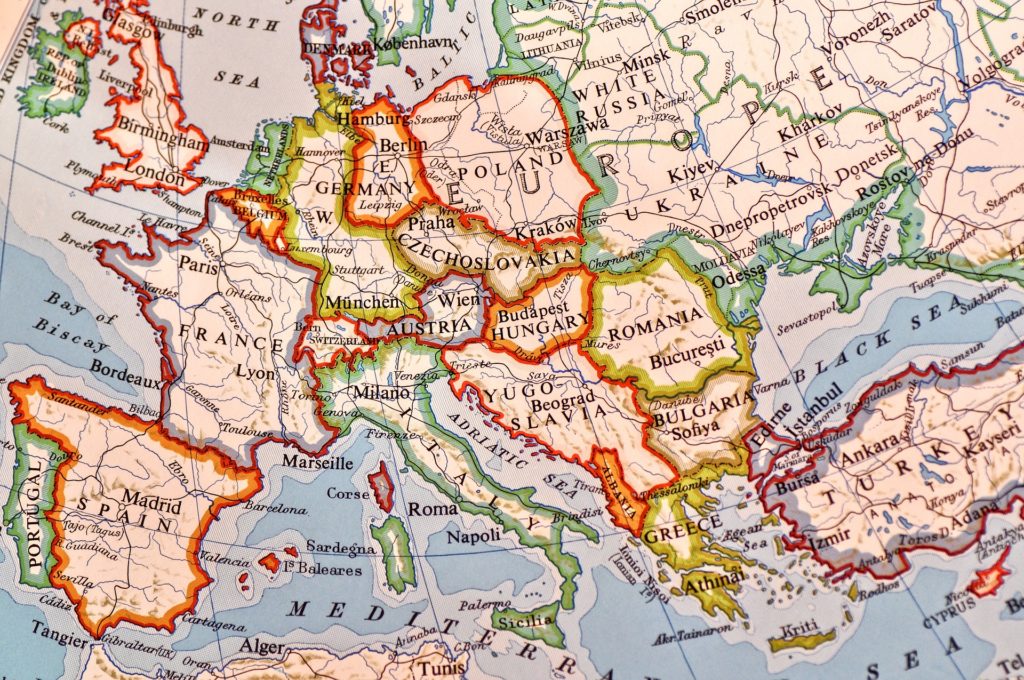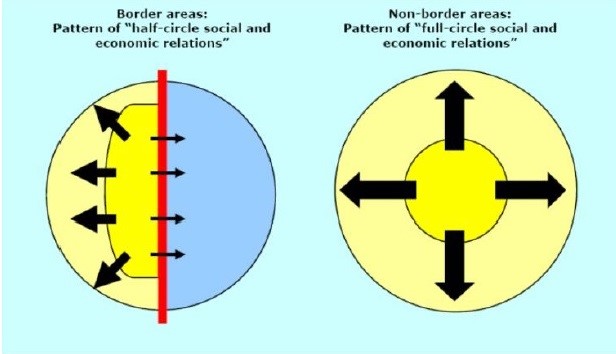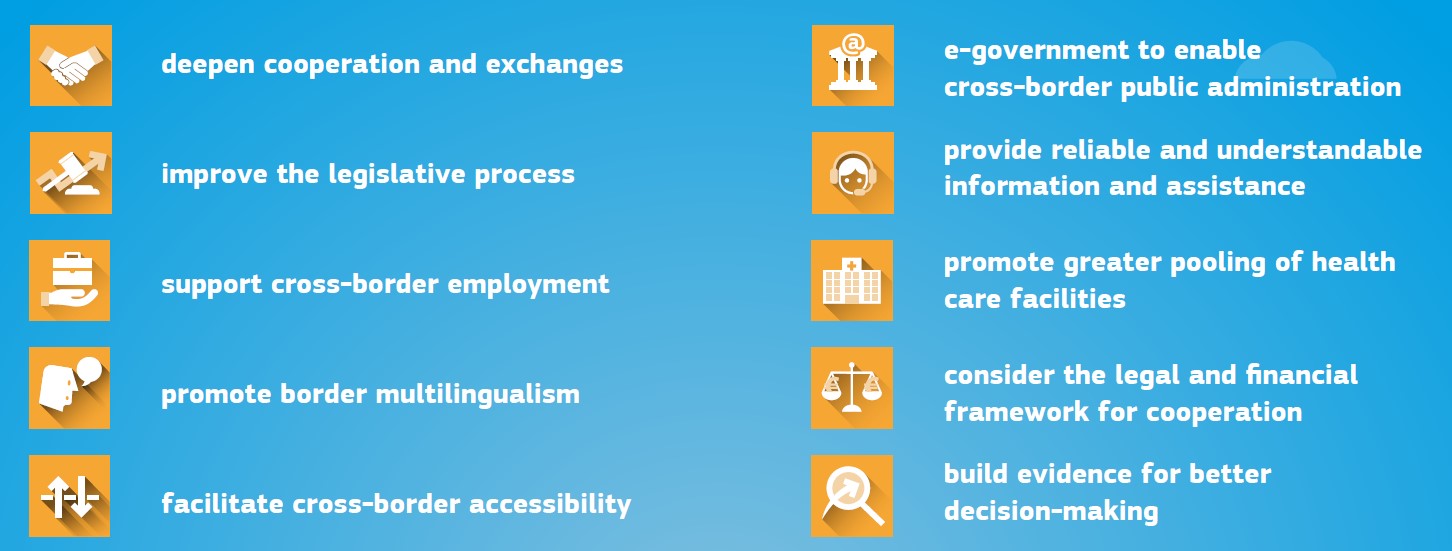Debating European Commission’s support to Cross-Border Cooperation: Time to move beyond funding

DOI reference: 10.1080/13673882.2018.00001033
By Ricardo Ferreira, Nathalie Verschelde and Valeria Cenacchi (European Commission, DG REGIO – Cross-Border Cooperation Unit)
Why support cross-border interactions?
For the readers of Regions eZine it is certainly not necessary to argue the importance of regional economics and how the development of regions is the basis for the development of a country. But when considering border regions we face a different story.
Humans have always lived with borders. They were one of the corner stones of economic policy until the end of mercantilism. Even when international trade theories led to a general acceptance of David Ricardo’s Comparative Advantage, borders remain so deeply en-rooted in our historic and cultural backgrounds that they keep on being a barrier, even when they are not.
But they are!
It is a frequent misperception that with the Single Market, borders within the European Union stopped representing a barrier to flows of people, goods and services. Reality shows us differently. EU internal borders still hamper economic and social interactions amongst contiguous regions, and this effect is not small. We could point two general groups of causes: the first are the cultural and tradition-based causes. The mere perception that there is a border leads individuals and companies to avoid exploring potential opportunities on the other side. Frequently it is the perception of potential obstacles that is the real obstacle. But even in that case, for an individual or an SME to overcome such perception would imply a learning process which has costs in itself. Being capable of knowing the law and administrative practices on both sides of the border is more resource-consuming than dealing with just one national framework, even if the two systems are fully coherent and compatible. This leads us to the second group of causes: legal and administrative obstacles. Too frequently incompatibilities or incoherencies amongst the applicable legal frameworks on two sides of a border hamper or impede interactions or projects across the border. The examples are endless and sometimes seem surreal: ambulances that cannot cross a border because of the colour of the light coming from the beacons; individuals who cannot apply for a job because qualifications are not accepted; public transport that cannot serve local stops as they constitute international travel. The list could continue far beyond the word limits of this article. De facto different legal frameworks hamper or impede interactions. In the best case, their impact is limited to the extra red-tape required for dealing simultaneously with two different administrative machines.
All these lead to a huge handicap for regions located by a border. Individuals and organisations located in those regions tend to look to their areas of influence (markets) without considering the other side of the border. Instead of addressing the territory within a certain radius with 360º coverage, they only face half of that area with a 180º perspective, as illustrated in Figure 1.

Figure 1. Border and non-border areas of influence. Source: European Commission (2017b)
The consequence is patently obvious. With smaller markets, or areas of influence, these territories do not achieve their full potential; furthermore, this lack of capacity of interactions across the border leads to these territories having lower access to public services, such as hospitals and universities (Monfort 2009). This effect on public services networks has a dual negative impact:
- As only half of the territory is taken into account, minimum sizes of areas of influence are frequently not met and, in many cases, services are not located in or near border regions;
- As the services on the other side of a border are not taken into account sometimes a duplication of general services exists, which can impede a potential specialisation of the existing ones.
This under-exploitation of the territory potential due to the existence of a border is generally referred to as the Border Effect. In the literature it is more frequently reported concerning trade flows, eg. Gil-Pareja et al (2006); Helble (2007); Ferreira et al (2011). References in other sectors can also be found as Public Procurement: Herz et al (2017). Magerman et al (2016) present different estimation methods for the Border Effect. Going beyond one specific sector, Capello et al (2018) present an interesting estimate of what the economic potential of overcoming legal and administrative obstacles is: “If only 20% of the existing obstacles were removed, border regions would still gain 2% in GDP. The estimated impact on jobs is equally important, with potential for over 1 million jobs” (EC 2017a).
Supporting cross-border interactions is thus a necessary condition to allow those territories to reach their full potential and trying to overcome those border effects. Article 174 of the Treaty on the Functioning of the European Union recognises the challenges faced by border regions and provides a legal framework for addressing them. Most frequently this support is merely understood as being the financial contribution provided by Interreg.
But it must go beyond financial support.
The recent past
Interreg has been providing that financial support since the 1990s. Its functioning, allocations and evaluations are frequent themes in the Regional Studies Association’s fora and in other publications (e.g. EC 2016). This financial support has an important effect of trust-building amongst actors on different sides of a border, a sine qua non condition for cooperation and interactions. A historic perspective of the evolution of Interreg can be found in Verschelde and Ferreira (2019).
On Interreg’s 25th anniversary, the Commission launched a reflection exercise called the Cross-Border Review. This has shown the need that, although financial support has been and will continue being vital, there are other actions to be taken. A focus has to be put on overcoming legal and administrative obstacle, which needs to be taken-up by different levels of administration and with the involvement of a diversity of stakeholders. Addressing those obstacles also requires engagement of stakeholders, sharing experiences and solutions and exploring new legislative tools to create the necessary frameworks under which actors in border regions can trigger the process to overcome border obstacles.
It was with these purposes that in 2017 the Commission adopted a Communication “Boosting Growth and Cohesion in EU Border Regions” (EC 2017a) and a Staff Working Document (EC 2017b) with a more thorough analysis. This Communication, along with making a strong call for engagement of all levels of administration, also included an action plan, and identified ten sectors that the Review highlighted as those needing urgent intervention, as illustrated in Figure 2:

Figure 2. Thematic areas addressed by EC Communication. Source: European Commission.
This list of sectors does not imply that obstacles are not experienced by others. The action plan included in the Communication is both an invitation for national and regional administrations to intervene within the remits of their competence. Only with such multilevel engagement can we expect a strong impact on cross-border regions.
To follow-up the different actions being implemented, and to promote sharing of practices amongst stakeholders, one of the first actions was the launch of an online platform Boosting EU Border Regions. Different experiences in different territories can be disseminated there by their promoters. Furthermore, the different outcomes of the actions are also accessible on this platform.
Bridging over legal obstacles
The EU institutions can have a strong role in overcoming legal and administrative obstacles, but they cannot act alone. The involvement of national, regional and local authorities is vital. To facilitate joint engagement of different administrations across borders, the EU has created the European Grouping of Territorial Cooperation – EGTC – (EU2006 and EU 2013) whose numbers have been increasing in the last years. But still there is more to be done, as frequently cross-border legal obstacles either cannot be solved because adequate legal frameworks are not available, or because those experiencing the problem (e.g. tose living in the cross-border territories) are not empowered with the legal competences to address them.
To this aim, the Commission has proposed a new Regulation (EC 2018) for a mechanism to overcome legal and administrative obstacles in a cross-border context (ECBM). If adopted, this regulation would create the legal framework for finding innovative solutions for specific problems, by allowing specific legal dispositions from one side of the border to be applicable on the other. This would be applied only within the well-defined and limited scope of cross-border projects, and on a case-by-case basis. In all cases these solutions would need approval from the corresponding national/regional authorities with legislative powers in each case.
Addressing parallel cases of legal obstacles are also being piloted. This is being done by the Commission who, together with the Association of European Border Regions (AEBR), launched the B-Solutions initiative (the B in the title refers to Border). Under this project, two calls for proposals have been launched. The first 10 projects were selected, addressing one specific obstacle each, and are now under implementation. Beneficiaries of these projects received a financial grant which supported an opportunity to bring together all the relevant stakeholders to devise solutions. Under the second call, selected applications will be granted technical support from legal experts to clearly document the root legal causes of obstacles being addressed, and to help devise potential solutions. In the coming months the results will be compiled and publicized in the above-mentioned platform. Hopefully this will be inspirational for other obstacles to be properly addressed. These cases would certainly become an interesting illustration of how ECMB could be applied when adopted.
Claim for cross-border data and research
As a concluding remark we would like to emphasise the need for more data and research on cross-border interactions. Many research lines address cross-border cooperation but with an emphasis on the financial side centred on Interreg. However, to best design cross-border policies, a wider spectrum of cross-border interactions must be more deeply understood. Little or no official data, depending on the location, is available on the flows of commuters (aka frontier workers); little analysis exists on the flows of patients residing in one border region and being treated across the border; or on individuals attending education systems across the border. Some research exists on quantification of border effects, but much more would be needed on its root causes. Similarly, deep analysis on how cross-border cooperation (e.g. through Interreg) is contributing to overcoming border effects and, thus, contributing for border regions to reach their potential, is desirable.
Readers of eZine who have ever addressed cross-border issues will have certainly experienced the limitations caused by lack of data and research. But the theme is exciting. We leave you the challenge of engaging in these research lines.
Disclaimer
Views expressed in this article do not necessarily represent an official position of the European Commission
References
Capello, Roberta; Caragliu, Andrea & Fratesi, Ugo (2018) “Measuring border effects in European cross-border regions”, Regional Studies, 52:7, 986-996, DOI: 10.1080/00343404.2017.1364843;
European Commission (2017a), Communication from the Commission to the Council and the European Parliament – Boosting Growth and Cohesion in European Border Regions, COM(2017)534;
European Commission (2017b), Commission Staff Working Document Accompanying the Commission Communication on Boosting Growth and Cohesion in EU Border Regions, SWD(2017)307;
European Commission (2018), Proposal for a Regulation of the European Parliament and of the Council on a mechanism to resolve legal and administrative obstacles in a cross-border context, COM(2018)373
European Union (2006), Regulation (EC) No 1082/2006 of the European Parliament and of the Council of 5 July 2006 on a European grouping of territorial cooperation (EGTC) (OJ L 210, 31.7.2006)
European Union (2013), Regulation (EU) No 1302/2013 of the European Parliament and of the Council of 17 December 2013 amending Regulation (EC) No 1082/2006 on a European grouping of territorial cooperation (EGTC) as regards the clarification, simplification and improvement of the establishment and functioning of such groupings (OJ L 347, 20.12.2013)
Ferreira, Ricardo; Mourato, Joaquim (2011): “Border Effect in Interregional Iberian Trade”, Journal of Economics and Business Research, Vol. XVII, No. 1, pp. 35-50;
Gil-Pareja, Salvador; llorca-vivero, Rafael & Martínez-Serrano, José A. (2006): “The border effect in Spain: The Basque Country case”, Regional Studies, 40:4, 335-345, DOI: 10.1080/00343400600725186;
Helble, M. (2007): “Border Effect Estimates for France and Germany Combining International Trade and Intranational Transport Flows”, Review of World Economics. DOI: 10.1007/s10290-007-0116-x;
Herz, Benedikt; Varela-irimia, Xosé-Luís (2017), “Border Effects in European Public Procurement”, SSRN Electronic Journal, DOI: 10.2139/ssrn.2883076
Magerman, G.; Studnicka, Z. and van Hove, J. (2016): “Distance and Border Effects in International Trade: A Comparison of Estimation Methods”, Economics: The Open-Access, Open Assessment EJournal, 10, pp. 1-31;
Monfort, Philippe (2009), ‘Territories with specific geographical features’, European Commissino REGIO Working Paper no: 2/2009.
Verschelde, N. and Ferreira, R. (2019): “Experiencias de cooperación transfronteriza en la Unión Europea y su impacto a nivel regional“, in Gordon, B.L. and Guillermo Ramírez, M. La cooperación transfronteriza para el desarrollo, Catarata, Madrid 2019. ISBN: 978-84-9097-605-0.